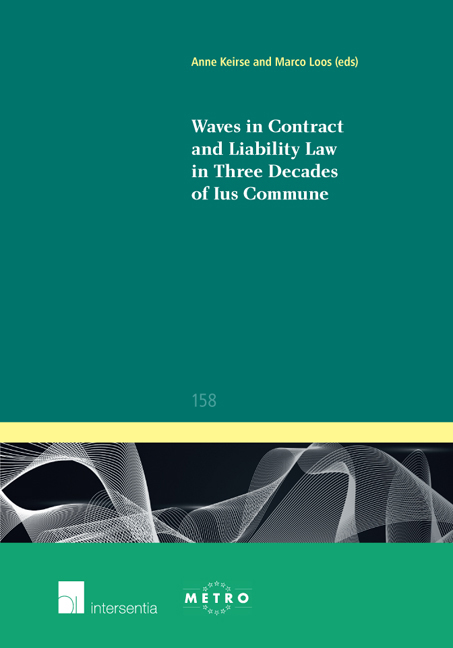Book contents
- Frontmatter
- Contents
- Introduction: The Waves of Contractual and Tortuous Liability
- Concurrence of Claims in Damages and EU Law
- The Procedural Position of a ‘Weaker Party’ in the Regulation Brussels Ibis
- The Principle of Equality as a Catalyst: The Increasing Influence of the Principle of Equality on the Belgian Law of Obligations
- ‘Where the Wild Things Are’ – Reflections on the State and Future of European Collective Redress
- Should Autonomous Agents be Liable for What They Do?
- Private Law Analogies and the Evolution of International State Responsibility for Acts of Non-Governmental Entities Exercising Decentralized/Privatized Governmental Functions
- IUS COMMUNE EUROPAEUM
Introduction: The Waves of Contractual and Tortuous Liability
Published online by Cambridge University Press: 13 October 2018
- Frontmatter
- Contents
- Introduction: The Waves of Contractual and Tortuous Liability
- Concurrence of Claims in Damages and EU Law
- The Procedural Position of a ‘Weaker Party’ in the Regulation Brussels Ibis
- The Principle of Equality as a Catalyst: The Increasing Influence of the Principle of Equality on the Belgian Law of Obligations
- ‘Where the Wild Things Are’ – Reflections on the State and Future of European Collective Redress
- Should Autonomous Agents be Liable for What They Do?
- Private Law Analogies and the Evolution of International State Responsibility for Acts of Non-Governmental Entities Exercising Decentralized/Privatized Governmental Functions
- IUS COMMUNE EUROPAEUM
Summary
As the 21st Ius Commune conference on European private law coincided with the 35th anniversary of the Maastricht law school, it was deemed a good occasion to look back at the evolutions that have taken place in the European law of obligations since 1981. More particularly, this book is the result from a discussion about how particular changes or developments have impacted both fields of contract law and tort law, either in the same or in diverging or even opposite ways.
Think, first of all, of the evolvement of different perceptions, for example in terms of (the need for) protection of the weaker party (e.g. consumer protection, and more recently small and medium-sized enterprises (SME) protection) and in respect of ‘freedom’ (e.g. the freedom to contract, the fault principle, etcetera). Secondly, in both fields of contract law and tort law it seems that there is an increased level of Europeanisation and constitutionalisation (with the 1991 Maastricht Treaty – celebrating its 25th birthday in the week after the Ius commune conference that took place in the city from where it takes its name – as one of the starting points). Hardly existing in the 1980s but currently at the core of scholarly attention in private law is the need to adjust the law to the growing impact of digitalisation. More and more, the law of obligations emerges from different (growing/evolving) sources of law. It emerges from all directions: top down, bottom up, but also crossing-over and diagonal. The law of obligations is not only the product of national lawmakers but also of supranational lawmakers and it concerns different types of actors. Norms of the law of obligations are not only being made by national legislators and courts, but also by European institutionalised lawmakers and (increasingly important) by private actors, organisations and networks. So too, in both areas of the law the focus seems to have shifted away from mere comparisons of national contract or tort law systems respectively to a growing call for European (or perhaps world-wide) harmonisation. Thirdly, in both fields of law there seems to be an emergence of new forms of regulation and of new kinds of remedies.
- Type
- Chapter
- Information
- Publisher: IntersentiaPrint publication year: 2017



